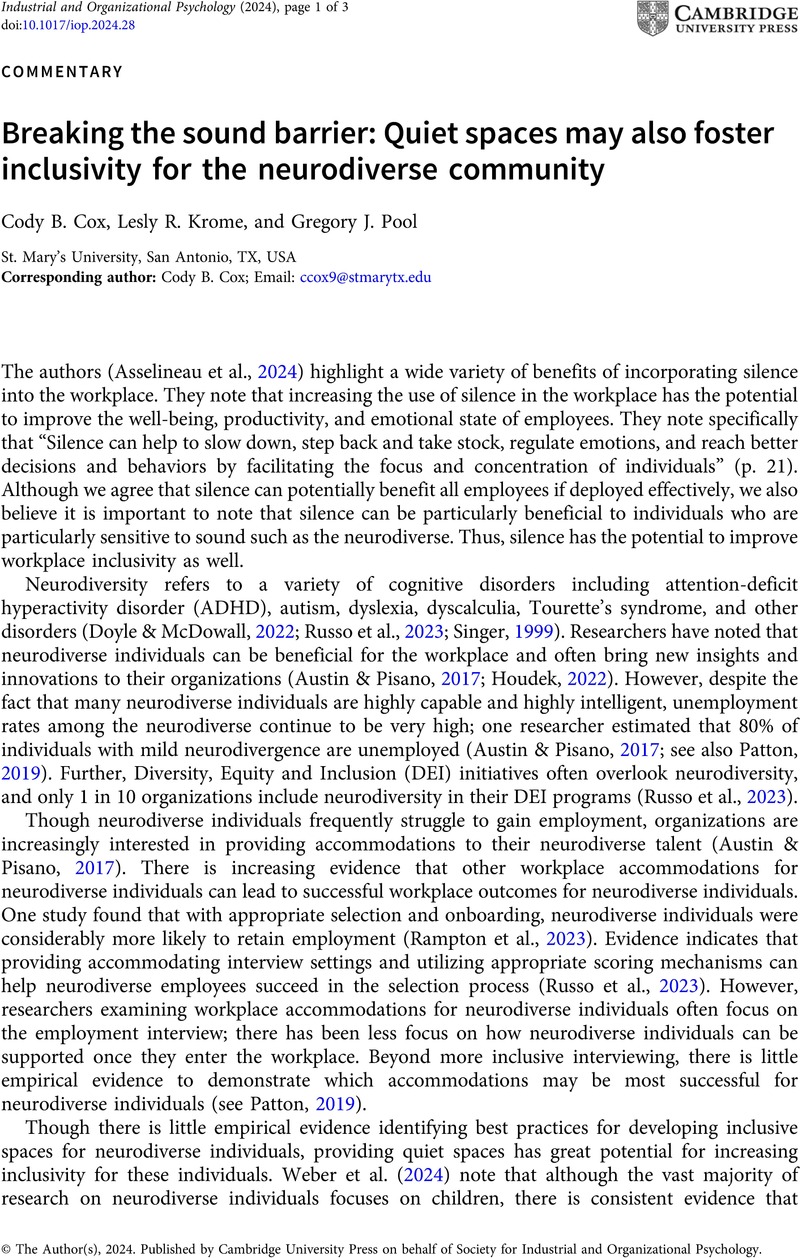No CrossRef data available.
Article contents
Breaking the sound barrier: Quiet spaces may also foster inclusivity for the neurodiverse community
Published online by Cambridge University Press: 03 September 2024
Abstract
An abstract is not available for this content so a preview has been provided. Please use the Get access link above for information on how to access this content.

- Type
- Commentaries
- Information
- Copyright
- © The Author(s), 2024. Published by Cambridge University Press on behalf of Society for Industrial and Organizational Psychology
References
Asselineau, A., Grolleau, G., & Mzoughi, N. (2024). Quiet environments and intentional practice of silence: Toward a new perspective in the analysis of silence in organizations. Industrial and Organizational Psychology, 17, 1–15.10.1017/iop.2024.9CrossRefGoogle Scholar
Austin, R. D., & Pisano, G. P. (2017). Neurodiversity as acompetitive advantage. Harvard Business Review, 95, 96–103.Google Scholar
Awada, M., Becerik-Gerber, B., Lucas, G., & Roll, S. (2022). Cognitive performance, creativity and stress levels of neurotypical young adults under different white noise levels. Scientific Reports, 12(1), 1–9, https://doi-org.blume.stmarytx.edu/10.1038/s41598-022-18862-w
CrossRefGoogle ScholarPubMed
Das, M., Tang, J., Ringland, K. E., & Piper, A. M. (2021). Towards accessible remote work: Understanding work-from-home practices of neurodivergent professionals. Proceedings of the ACM on Human-Computer Interaction, 5(CSCW1), 1–30.Google Scholar
Doyle, N., & McDowall, A. (2022). Diamond in the rough? An “empty review” of research into “neurodiversity” and a road map for developing the inclusion agenda. Equality, Diversity and Inclusion, 41(3), 352–382. https://doi.org/10.1108/EDI-06-2020-0172
CrossRefGoogle Scholar
Hayward, S. M., McVilly, K. R., & Stokes, M. A. (2019). Autism and employment: What works. Research in Autism Spectrum Disorders, 60, 48–58.10.1016/j.rasd.2019.01.006CrossRefGoogle Scholar
Houdek, P. (2022). Neurodiversity in (not only) public organizations: An untapped opportunity? Administration & Society, 54(9), 1–24. https://doi.org/10.1177/00953997211069915
CrossRefGoogle Scholar
Ovaska-Few, S. (2018). Promoting neurodiversity: A pilot program at EY recruits workers with autism. Journal of Accountancy, 225(1). Retrieved from: https://www.journalofaccountancy.com/issues/2018/jan/ey-pilot-program-workers-with-autism.html
Google Scholar
Patton, E. (2019). Autism, attributions and accommodations: Overcoming barriers and integrating a neurodiverse workforce. Personnel Review, 48, 4, 915–934. https://doi.org/10.1108/PR-04-2018-0116
CrossRefGoogle Scholar
Rampton, G., Remiz, F., & DiRezze, B. (2023). Early employment outcomes for individuals on the autism spectrum: When judiciously selected and supported for competitive employment in highly skilled technical jobs. Consulting Psychology Journal, 75(4), 354–368, https://doi-org.blume.stmarytx.edu/10.1037/cpb0000225
CrossRefGoogle Scholar
Russo, E. R., Ott, D. L., & Moeller, M. (2023). Helping neurodivergent employees succeed. MIT Sloan Management Review, 64(3), 46–51.Google Scholar
Singer, J. (1999). Why can’t you be normal for once in your life?” From a problem with no name to the emergence of a new category of difference. In Corker, M., & French, S. (Eds.), Disability discourse (pp. 59–67). Open University Press.Google Scholar
Szulc, J. M., McGregor, F. L., & Cakir, E. (2023). Neurodiversity and remote work in times of crisis: Lessons for HR. Personnel Review, 52(6), 1677–1692.10.1108/PR-06-2021-0469CrossRefGoogle Scholar
Weber, C., Krieger, B., Häne, E., Yarker, J., & McDowall, A. (2024). Physical workplace adjustments to support neurodivergent workers: A systematic review. Applied Psychology, 73(3), 910–962.10.1111/apps.12431CrossRefGoogle Scholar


